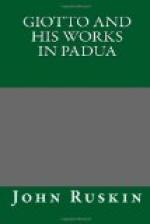In our modern art we have indeed lost sight of one great principle which regulated that of the middle ages, namely, that chiaroscuro and colour are incompatible in their highest degrees. Wherever chiaroscuro enters, colour must lose some of its brilliancy. There is no shade in a rainbow, nor in an opal, nor in a piece of mother-of-pearl, nor in a well-designed painted window; only various hues of perfect colour. The best pictures, by subduing their colour and conventionalising their chiaroscuro, reconcile both in their diminished degrees; but a perfect light and shade cannot be given without considerable loss of liveliness in colour. Hence the supposed inferiority of Tintoret to Titian. Tintoret is, in reality, the greater colourist of the two; but he could not bear to falsify his light and shadow enough to set off his colour. Titian nearly strikes the exact mean between the painted glass of the 13th century and Rembrandt; while Giotto closely approaches the system of painted glass, and hence his compositions lose grievously by being translated into black and white.
But even this chiaroscuro, however subdued, is not without a peculiar charm; and the accompanying engravings possess a marked superiority over all that have hitherto been made from the works of this painter, in rendering this chiaroscuro, as far as possible, together with the effect of the local colours. The true appreciation of art has been retarded for many years by the habit of trusting to outlines as a sufficient expression of the sentiment of compositions; whereas in all truly great designs, of whatever age, it is never the outline, but the disposition of the masses, whether of shade or colour, on which the real power of the work depends. For instance, in Plate III. (The Angel appears to Anna), the interest of the composition depends entirely upon the broad shadows which fill the spaces of the chamber, and of the external passage in which the attendant is sitting. This shade explains the whole scene in a moment: gives prominence to the curtain and coverlid of the homely bed, and the rude chest and trestles which form the poor furniture of the house; and conducts the eye easily and instantly to the three figures, which, had the scene been expressed in outline only, we should have had to trace out with some care and difficulty among the pillars of the loggia and folds of the curtains. So also the relief of the faces in light against the dark sky is of peculiar value in the compositions No. X. and No. XII.
The drawing of Giotto is, of course, exceedingly faulty. His knowledge of the human figure is deficient; and this, the necessary drawback in all works of the period, occasions an extreme difficulty in rendering them faithfully in an engraving. For wherever there is good and legitimate drawing, the ordinary education of a modern draughtsman enables him to copy it with tolerable accuracy; but when once the true forms of nature are departed from, it is by




